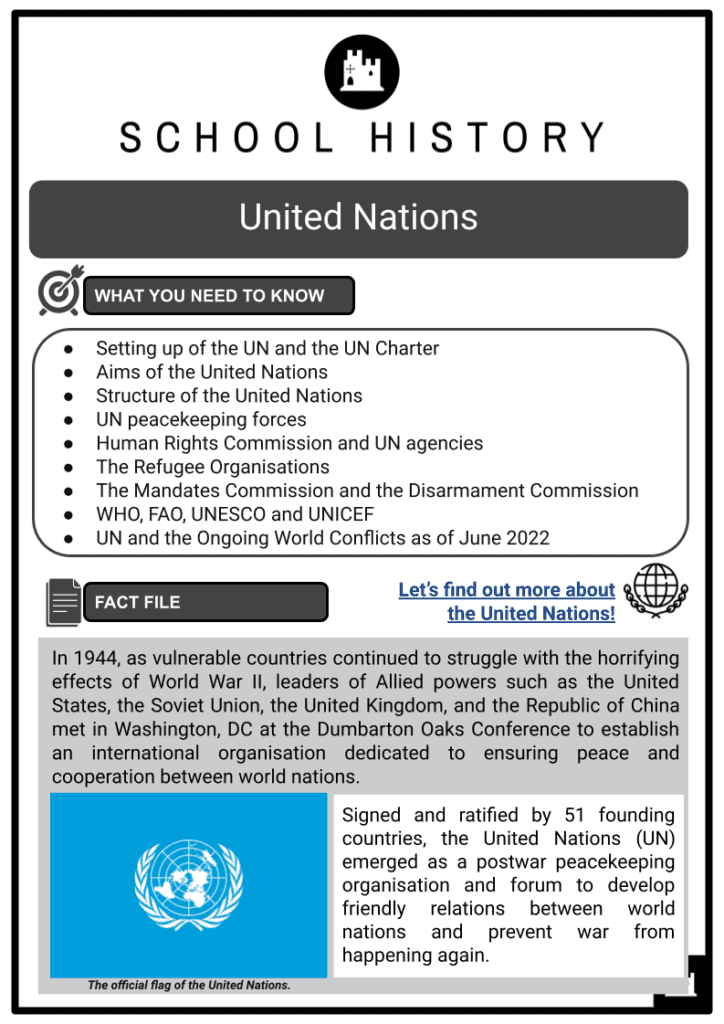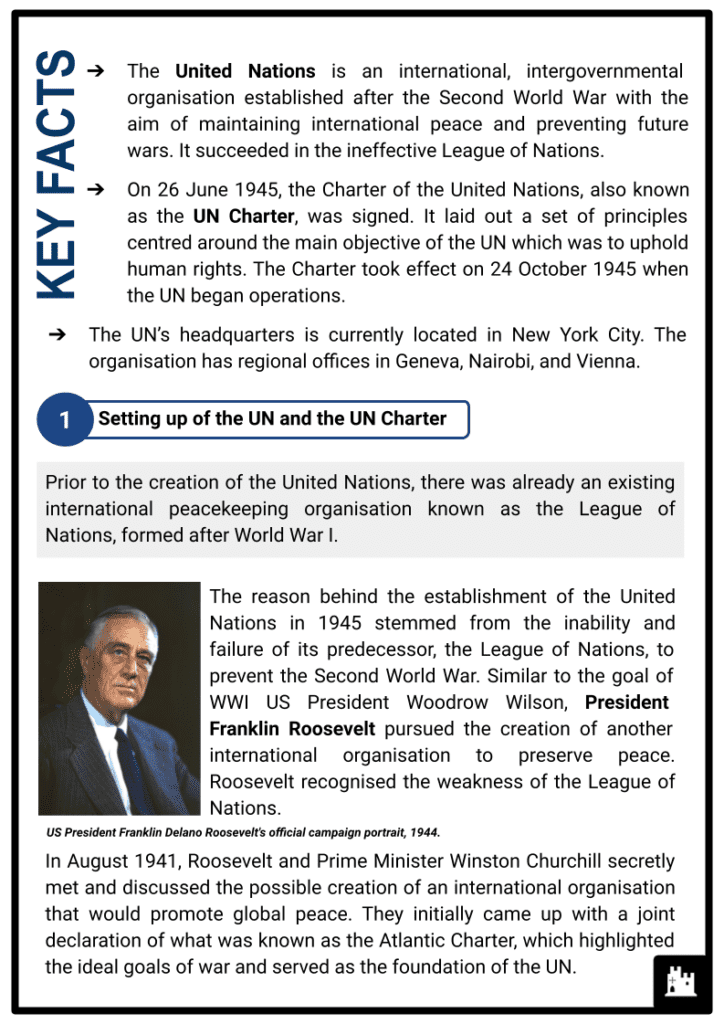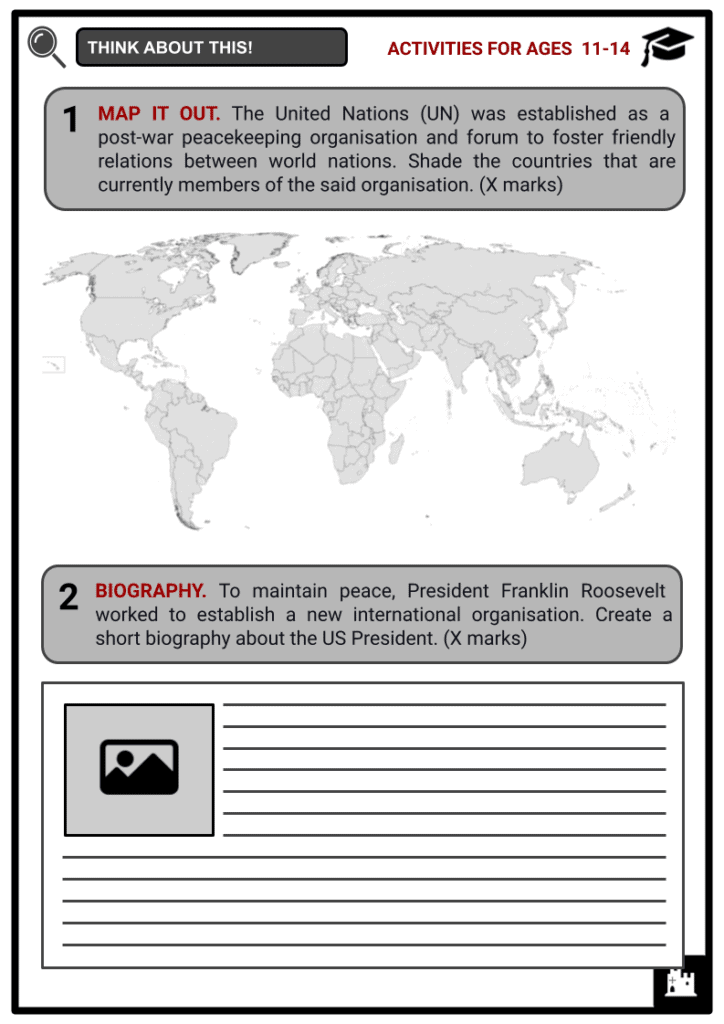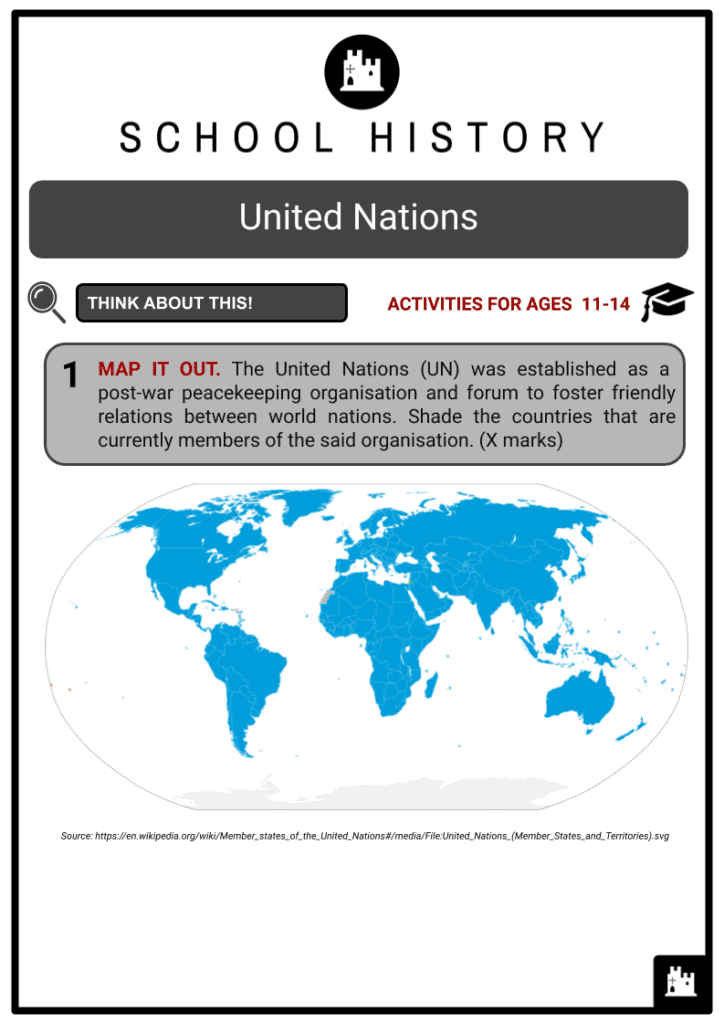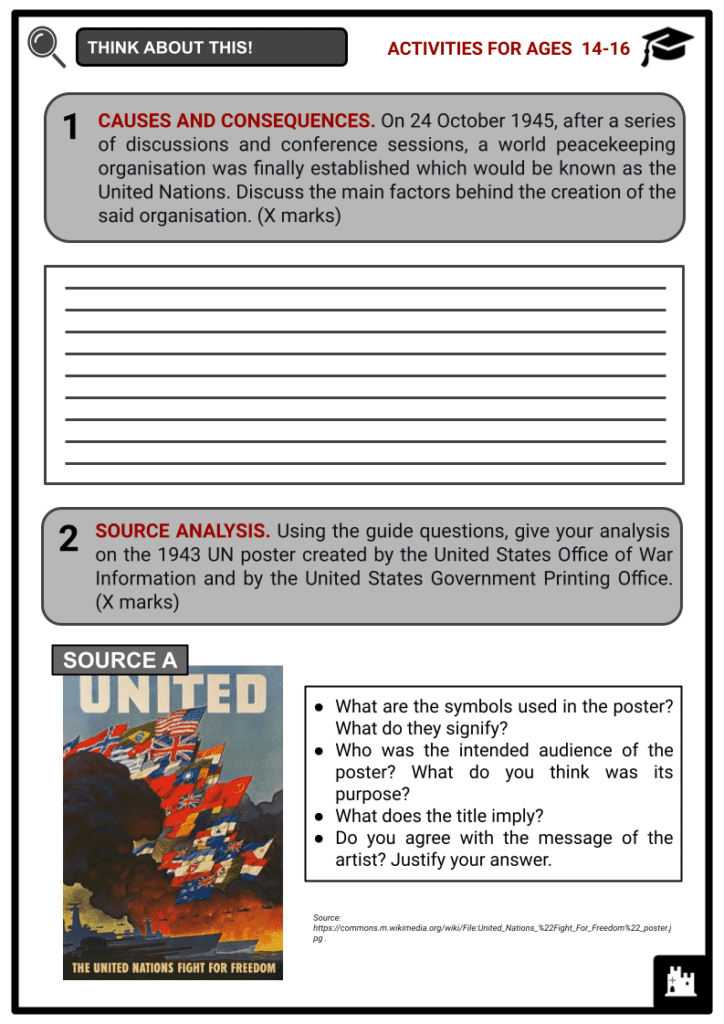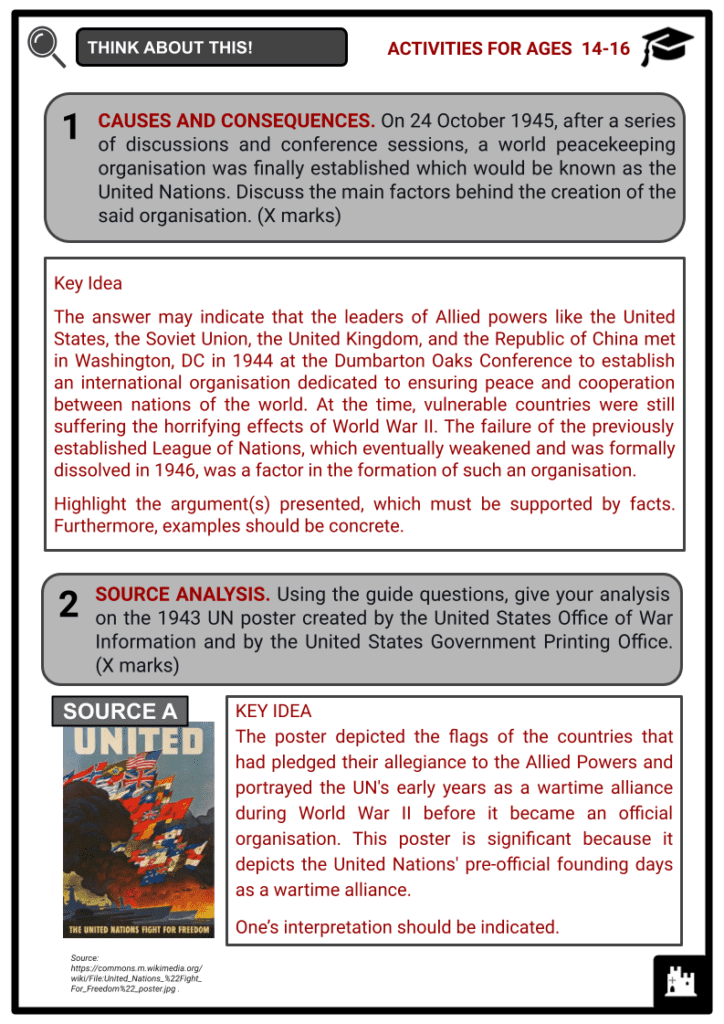United Nations Worksheets
Do you want to save dozens of hours in time? Get your evenings and weekends back? Be able to teach about the United Nations to your students?
Our worksheet bundle includes a fact file and printable worksheets and student activities. Perfect for both the classroom and homeschooling!
Summary
- Setting up of the UN and the UN Charter
- Aims of the United Nations
- Structure of the United Nations
- UN peacekeeping forces
- Human Rights Commission and UN agencies
- The Refugee Organisations
- The Mandates Commission and the Disarmament Commission
- WHO, FAO, UNESCO and UNICEF
- UN and the Ongoing World Conflicts as of June 2022
Key Facts And Information
Let’s find out more about the United Nations!
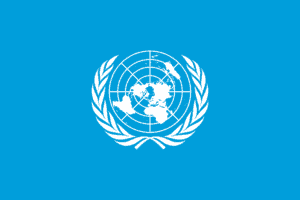
In 1944, as vulnerable countries continued to struggle with the horrifying effects of World War II, leaders of Allied powers such as the United States, the Soviet Union, the United Kingdom, and the Republic of China met in Washington, DC at the Dumbarton Oaks Conference to establish an international organisation dedicated to ensuring peace and cooperation between world nations. Signed and ratified by 51 founding countries, the United Nations (UN) emerged as a postwar peacekeeping organisation and forum to develop friendly relations between world nations and prevent war from happening again.
Key Facts
- The United Nations is an international, intergovernmental organisation established after the Second World War with the aim of maintaining international peace and preventing future wars. It succeeded in the ineffective League of Nations.
- On 26 June 1945, the Charter of the United Nations, also known as the UN Charter, was signed. It laid out a set of principles centred around the main objective of the UN which was to uphold human rights. The Charter took effect on 24 October 1945 when the UN began operations.
- The UN’s headquarters is currently located in New York City. The organisation has regional offices in Geneva, Nairobi, and Vienna.
Setting up of the UN and the UN Charter
- Prior to the creation of the United Nations, there was already an existing international peacekeeping organisation known as the League of Nations, formed after World War I.
- The reason behind the establishment of the United Nations in 1945 stemmed from the inability and failure of its predecessor, the League of Nations, to prevent the Second World War. Similar to the goal of WWI US President Woodrow Wilson, President Franklin Roosevelt pursued the creation of another international organisation to preserve peace. Roosevelt recognised the weakness of the League of Nations.
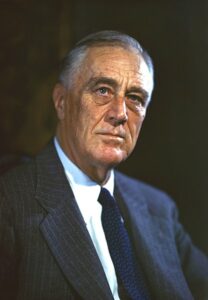
US President Franklin Delano Roosevelt's official campaign portrait, 1944. - In August 1941, Roosevelt and Prime Minister Winston Churchill secretly met and discussed the possible creation of an international organisation that would promote global peace. They initially came up with a joint declaration of what was known as the Atlantic Charter, which highlighted the ideal goals of war and served as the foundation of the UN.
- Although not considered an official treaty, the Atlantic Charter affirmed the basic principles of universal human rights and became a promise of hope for countries controlled by the Axis powers. It was eventually signed by the USSR, nine exiled governments of occupied Europe, and France on September 24.
- On 1 January 1942, leaders of Allied nations signed the United Nations Declaration, during which the term was officially coined by the Allies in reference to their alliance. Originally, the declaration had 26 signatories that pledged to support the Atlantic Charter and promised not to negotiate peace with Axis powers.
- Following this, the signing of the Moscow Declaration in October 1943 and the conference in Tehran, Iran on December 1943 happened to plan strategies to win the war against Axis powers and establish a world organisation that would maintain peace and security.
- Between 1944-1945, the Dumbarton Oaks and Yalta Conference took place. The meetings, held in a private mansion in Washington, DC, focused on the creation of a blueprint and discussions about the structure of the UN, different from the ineffective Covenant of the League of Nations.
- From 25 April to 26 June 1945, world nations that had signed the UN Declaration and declared war against the Axis powers, and other four sponsors and invited countries, partook in the San Francisco Conference to draft the UN Charter that would be agreeable to all countries.
- About 85 per cent of the world's population was represented by the 850 delegates at the said conference with more than 3,500 total attendees and over 2,500 media representatives from various organisations, making this event the largest international gathering to ever take place.
- On 24 October 1945, after all, controversial issues were resolved and conditions were fulfilled through a two-month series of discussions and conference sessions, a world peacekeeping organisation was finally established which would be known as the United Nations.
Aims of the United Nations
- To maintain international peace and security.
- To develop friendly relations among nations on the basis of equality and the principle of self-determination.
- To foster worldwide cooperation in solving economic, social, cultural and humanitarian problems.
- To promote human rights and fundamental freedom for the people of the world.
- To serve as a centre where various nations can coordinate their activities towards the attainment of the objectives of the United Nations.
- To save succeeding generations from the scourge of war.
From 51 founding members, the United Nations today is composed of 193 member states. Through the UN Security Council recommendation and a two-thirds vote from the General Assembly, new members are accepted. Since its inception, the UN has provided various environmental, humanitarian, and peacekeeping initiatives, including the following:
- Food for 90 million people in over 75 developing countries.
- Cooperation with over 140 nations to minimise climate change.
- Provided assistance to about 34 million refugees.
- Health vaccinations to about 58% of children in the world.
- Protection of human rights through 80 treaties and declarations.
- Initiated about 71 peacekeeping missions.
Structure of the United Nations
SECRETARIAT
- Headed by the Secretary-General, this organ carries out the day-to-day work of the organisation. As chief administrative officer, the Secretary-General, appointed by the Assembly, serves a five-year renewable term.
SECURITY COUNCIL
- With main aims of maintaining international peace and security, the UN Security Council has 5 permanent members and 10 non-permanent (elected for 2 year terms).
GENERAL ASSEMBLY
- The General Assembly is the policy-making body represented by all 193 member states. The Assembly meets once a year, every September, for a general debate and session.
- Economic and Social Council
- International Criminal Court
- International Court of Justice
UN Peacekeeping Forces
- The United Nations Peacekeeping Forces was an international armed force first sent on a mission in 1948 to observe the ceasefire of the Israeli–Palestinian conflict.
- Peacekeeping is the practice of creating conditions for peace in countries torn by conflict. Peacekeeping missions involve the use of international armed forces as a buffer between conflicting countries. Peacekeeping missions were not mentioned in the UN Charter but were formalised in 1956 during the Suez Crisis. Peacekeeping troops involve troops from various countries, who serve under the authority of the UN Security Council. The Security Council established more complex UN peacekeeping missions when the Cold War came to an end. Peacekeeping evolved to encompass both military and civilian elements, such as elections.
- Once a peace treaty has been negotiated, the parties involved could ask the United Nations for peacekeeping forces to oversee the elements and execution of the treaty. Since 1948, nearly 130 nations have contributed military and civilian troops to peace operations. The UN Peacekeeping Forces were awarded the Nobel Prize for Peace in 1988.
Human Rights Commission and UN agencies
UNITED NATIONS COMMISSION ON HUMAN RIGHTS
- The United Nations Commission on Human Rights was established in 1946. The Commission was tasked to examine, monitor and report on human rights conditions in certain countries or territories. It also provided a forum where countries, non-governmental groups, and human rights advocates raised their concerns.
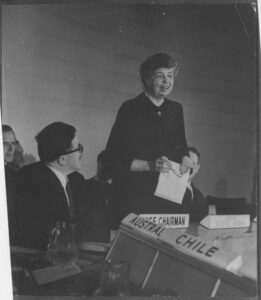
Eleanor Roosevelt at United Nations for Human Rights Commission meeting in Lake Success, New York in 1947 - From 1947 to 1967, the commission focused its efforts on promoting human rights and helping states draft treaties. Beginning in 1967, the Commission became more interventionist in its approach and policy. This means the Commission would also investigate, report, and condemn human rights violators. From then on, certain developments such as geographically-oriented and theme-oriented workgroups were viewed as better measures in dealing with violations, but these developments did not turn out as effective as they had hoped.
SPECIALISED AGENCIES OF THE UNITED NATIONS
- UNDP or UNITED NATIONS DEVELOPMENT PROGRAMME. Active in about 170 countries aiming to eradicate poverty, reduce inequalities, and promote sustainable progress.
- UNEP or UNITED NATIONS ENVIRONMENT PROGRAMME. Beginning in 1972, the UNEP advocates for and promotes the sustainable development of the environment.
- UNFPA or UNITED NATIONS POPULATION FUND. A UN agency which secures healthy, safe, and wanted pregnancies and that every young person’s potential is fulfilled.
- UN-Habitat or UNITED NATIONS HUMAN SETTLEMENTS PROGRAMME. UN Habitats promotes adequate shelter and sustainable human settlements for all.
- UNICEF or UNITED NATIONS CHILDREN'S FUND. With headquarters in New York City, UNICEF aims to save children’s lives all over the world by defending their rights and supporting their full potential.
- WFP or WORLD FOOD PROGRAMME. This humanitarian agency aims to eradicate malnutrition and hunger.
HEADQUARTERS OF ADDITIONAL SPECIALISED AGENCIES OF THE UNITED NATIONS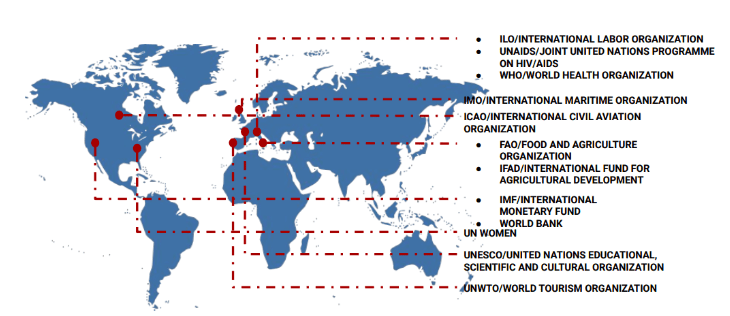
THE INTERNATIONAL LABOUR ORGANISATION
- The International Labour Organisation (ILO) is a UN agency mandated to improve working conditions, facilitate social justice, and uphold international labour standards. It was established in 1919 and affiliated with the League of Nations. In 1946, the ILO became the first affiliated specialised agency of the United Nations.
- In the 1920s, the ILO focused on developing labour legislation for adoption by member states and arranging collaborative efforts among its organisation, the government, and the labour sector.
- The ILO worked on acting against widespread unemployment when the Great Depression hit during the 1930s. As the ILO included less developed countries in its membership, the organisation addressed new issues such as child labour and the liberalisation of international trade. Both government representatives and trade union representatives are included in the ILO’s membership.

Photograph of international leaders and staff at the International Labour Conference in Washington, D.C., 1919
The Refugee Organisations
UNITED NATIONS HIGH COMMISSIONER FOR REFUGEES (UNHCR)
- In 1947, the United Nations founded the International Refugee Organisation (IRO), which was the first international agency to oversee refugee issues globally. When the IRO dissolved, the High Commissioner for Refugees was established.
- The UN High Commissioner for Refugees is an agency created in 1950 mandated to protect the rights of refugees and assist in their repatriation and integration into a new country. The UNHCR’s scope does not include Palestinian refugees because they are assisted by UNRWA.
- To better achieve their goal of protecting refugees, the UNHCR partners with other agencies part of the United Nations, such as the Food and Agricultural Organisation, the Human Rights Commission, the Entity for Gender Equality, and so on.
- The 1951 Refugee Convention expanded the scope of refugees to ones outside Europe.
- That wider scope of mandate became more prominent in the late 1950s, as the UNHCR responded to refugees in Hong Kong and Algeria.
- Large refugee movements in Africa were organised in the 1960s following decolonisation.
- The number of refugees skyrocketed in the 1970s. The UNHCR faced challenges in the 1980s when member states were unwilling to resettle the huge number of refugees.
The Mandates Commission and the Disarmament Commission
UNITED NATIONS DISARMAMENT COMMISSION (UNDC)
- The Disarmament Commission was established on 11 January 1952 under the United Nations General Assembly and the mandate of dealing with disarmament issues. The UNDC’s tasks are to regulate and reduce armed forces and all weapons, including nuclear disarmament and mass destruction weapons, through preparing treaty proposals.
- A number of disarmament-oriented committees formed in the UN following the establishment of the UNDC and the second iteration of the commission were created on 30 June 1978.
TRUSTEESHIP COUNCIL
- The Mandates Commission established in 1919 by the League of Nations existed until 1946 when the United Nations replaced it with the Trusteeship Council. Mandated territories became known as trust territories.
- As one of the primary organs of the UN, the Trusteeship Council supervises the government of trust territories in the best interest of the residents until they reach self-government. The last trust territory to achieve self-government was Palau in 1994, which marked the fulfillment of its mission and, thus, the termination of its activities.
WHO, FAO, UNESCO and UNICEF
- WHO or WORLD HEALTH ORGANISATION. A specialised UN agency established in 1948 that deals with matters concerning global public health. The agency’s goal is to ensure better health for people worldwide and lead with responses to medical emergencies.
- FAO or FOOD AND AGRICULTURE ORGANISATION. This is the oldest existing agency of the UN. Founded in 1945, the FAO is concerned with ensuring food security, promoting nutrition, and defeating world hunger. Its motto “Fiat Panis” is Latin for “Let there be bread.”
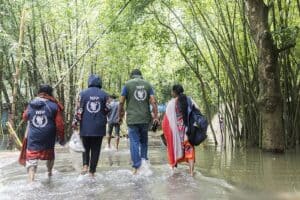
The WFP in the floods in Bangladesh, 2019 - UNESCO or UNITED NATIONS EDUCATIONAL, SCIENTIFIC AND CULTURAL ORGANISATION. UNESCO champions human rights and world peace through international cooperation in education, sciences, and culture.
- UNICEF or UNITED NATIONS CHILDREN’S FUND. Established in 1946, this UN agency provides humanitarian aid to children worldwide. UNICEF seeks to protect children’s rights through developing policies and partnering with various organisations.
UN and the Ongoing World Conflicts as of June 2022
- Between 1947 and 1949, at least 15,000 Palestinians were killed, while 750,000 were displaced. Between 2000 and 2014, more than 7,000 Palestinian and 1,100 Israelis were killed in the conflict. The US used its veto power to counter UN Security Council resolutions against Israel. The Kashmir dispute between India and Pakistan since 1948 caused chaos in the region.
- When North Korea invaded South Korea on 25 June 1950, the Korean War began. The United Nations joined the war on the side of South Korea. For this reason, the United Nations Command was formed by the United Nations Security Council. The Korean War came to an end in July 1953 with nearly 5 million people killed. More than half of them were civilians, which is more than the civilian death tolls during the Vietnam War and World War II.
- From 1960 to 1964, the Republic of Congo fell into crisis and disorder after it gained independence from Belgium. To aid in the restoration of peace and order in Congo, the UN peacekeeping forces formed the United Nations Operation in the Congo. A UN peacekeeping force was established in Congo and stayed there until 1964. The main goals of the force were to have Belgian military troops withdrawn and to provide military assistance to Congo. Although the UN force extended beyond being a self-defence and peacekeeping force into a military one in 1961, those objectives never changed.
- Since the ousting of dictator Mohamed Siad Barre in 1991, Somalia has been in chaos because of rival clans. The failure of the UN Peacekeeping forces to subdue the civil war and control famine caused the death of about 500,000 civilians.
- The rebellion in Darfur, Sudan killed some 200,000 people, while over 2.5 million people became refugees. In 2009, the UN International Criminal Court issued arrest warrants against Sudanese President Omar Hassan al Bashir.
- Bashar al-Assad released imprisoned Al Qaeda members. While the UN Security Council passed several resolutions to solve the conflict, Russia used its veto power. Because of the conflict, about one-third of the population were refugees.
- The civil war which began after the separation of South Sudan caused the deaths of at least 382,000 people. Despite the presence of more than 14,500 UN peacekeeping officers, South Sudan is suffering from food insecurity.
- The Rohingya Crisis in Myanmar killed almost 24,000 civilians and made 750,000 refugees in Bangladesh. China blocked the efforts of the UN Security Council.
- Following the withdrawal of US troops from Afghanistan, the extremist group the Taliban took over the Afghan government. Because of this, UN humanitarian assistance in Afghanistan became difficult to almost impossible after the attacks in Kazakhstan.
- In February, Russian leader Vladimir Putin announced a special military operation against Ukraine. Unlike the UN, the European Union responded to the aggression by financing the purchase of weapons and other equipment to Ukraine.
Image Sources
- https://commons.wikimedia.org/wiki/File:Flag_of_the_United_Nations.svg
- https://commons.wikimedia.org/wiki/File:FDR_1944_Color_Portrait.jpg
- https://commons.wikimedia.org/wiki/File:Eleanor_Roosevelt_at_United_Nations_for_Human_Rights_Commission_meeting_in_Lake_Success,_New_York_-_NARA_-_196772.jpg
- https://commons.wikimedia.org/wiki/File:1919-ILC-secretariatstaff.jpg
- https://commons.wikimedia.org/wiki/File:Bangladesh_WFP_Sayed_Asif_Mahmud.jpg

